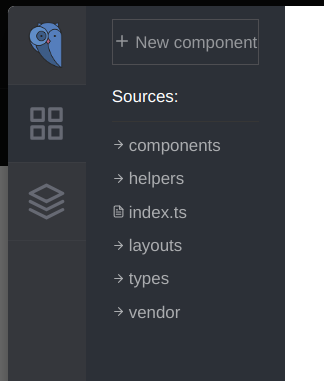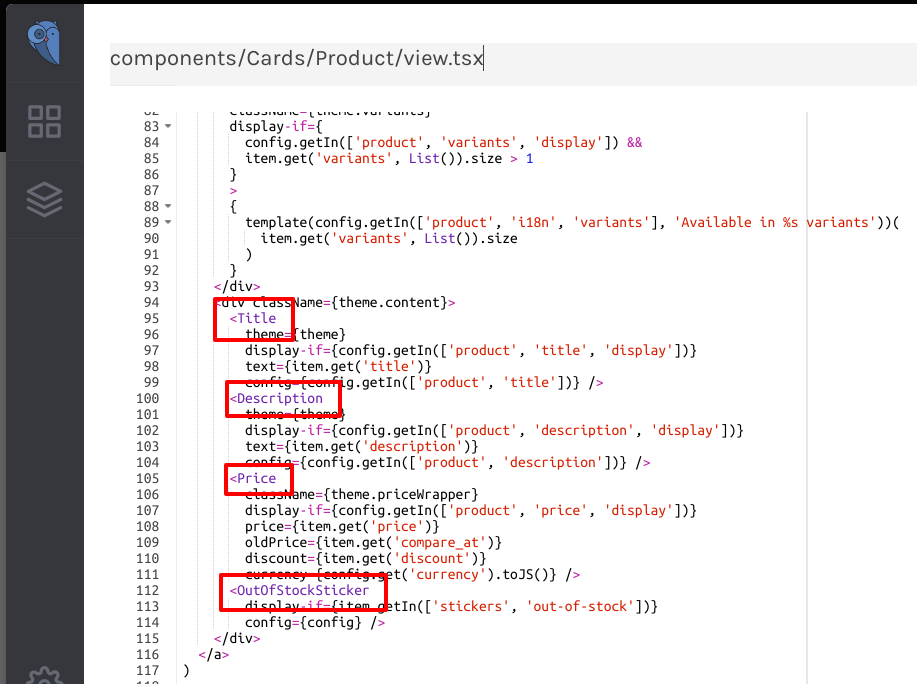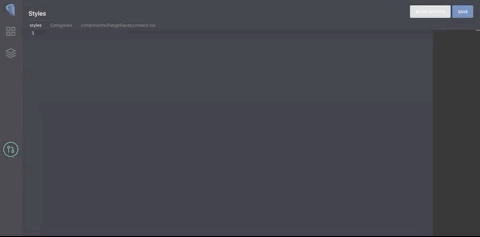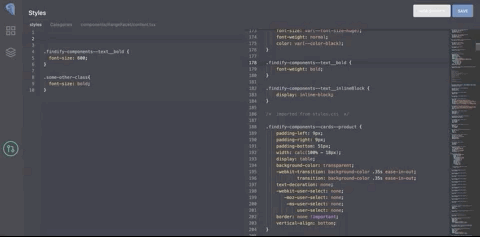Using the Findify React devtools
Learn how to install the Findify React devtools and begin to use it immediately!
What you will learn here
The Findify React Devtools extension is a complete toolbox to modify every visual aspect of the Findify Search, Recommendations and Smart-collections.
In this hands-on guide, you will learn how to:
- Install the Chrome extension
- Enable it with your store
- Understand how the extension is structured
- Manipulate any component
- Create a new component
Install the Chrome extension
Use this link to install the extension in your Chrome browser.
Once this is done, go to your store. The Findify icon next to your URL box should become colorful: the Findify extension is ready to be used. Click on it!

Click on the Findify icon to open the devtools interface
- Type the email and password that you use to login to the Findify Merchant Dashboard.
- In the dropdown, select the name of your store you would like to make modifications on.
- The interface of the extension should then appear with the components and styles of your store.
What should I look at in the Chrome extension?
The content of the Chrome extension can be hard to understand at first but no worries, we will get you covered in a few minutes!
Components

Left panel in the Chrome extension
Components are the low-level blocks. Every experience in Findify is composed of several blocks. For instance, the search results page is composed of 3 components: ItemsList, Pagination and Powered by.
Some components are themselves built using other components. For instance, ItemsList has an array of the component Cards / Products. Each Product contains the components Image, a DiscountSticker, a Rating (for the review), a Title, a Description and a Price.

Components that are part of Cards / Products
Every component has always at least the 2 following files: index.ts, view.tsx.
index.ts contains the logic of the component: what happens when you click on a button, when a filter is clicked, etc. We usually do not recommand to modify this file as wrong manipulations can have unexpected results. Be careful if you do!
view.tsx contains the visual description of the component. This is often the file you would need to modify so the interface fits what you would like to display.
What is .ts and .tsx?
These extensions characterize Typescript files. Typescript is a superset of Javascript that compiles to Javascript. In Findify, we use Typescript because of its static typing advantage.
Styles
In order to modify the styles of a component, click on the Styles button.

Clicking on the styles button will display the CSS styles. Clicking on Show Source will display default Findify styles. You can right click and use 'Pick definition' to copy over the selector
You will see all the CSS for all the components in this section. In order to simplify your life, the CSS section supports autocompletion, variable definitions and nested rules.
By default you will see the empty editor with no styles, as the editor only shows styles that you've added on top of the default styling.
You can show default styles by clicking 'Show Source' button in the top right side of the screen.

Autocompletion and CSS spell check are available in the editor
You can override default styling by using the same selector and providing updated properties in the selector. Our build system will then check if you use the selector that already exists in the default CSS file and will override exactly the property that you have specified.
The build system will not merge rules that are not present in our default CSS and will just add them to the end of the file, so you can use extra styles if needed as before.
To make it easier to modify default styles, we've added a Pick function that will copy over the style definition into the working editor that you can invoke by right clicking on the style definition in the default source code.
Known issues with overriding default CSS
- If you want to override a style that include '@supports' definition, you need to override it together with @supports
Try it to learn!
In order to get more knowledge about the components in the Merchant JS, open the extension and look at the view definition of the following components:
- Card / Product
- Sorting
Creating a button "Add to cart" in the product box
Create a new component
In this section, we will create a "Add to cart" button that will appear in the product box. Clicking on this button will add the product from the box to your ecommerce cart.
We have 2 options to add this "Add to cart" button:
- We can create the component inside the view
components/Cards/Product/view.tsx. - We can create a standalone component with its own path (
components/AddToCart/view.tsx) and import it in thecomponents/Cards/Product/view.tsxview file.
For this tutorial, we will select the first option.
Here is the code we will insert in the file components/Cards/Product/view.tsx:
import { withHandlers } from 'recompose';
const AddToCartButton = withHandlers({
onClick: ({ item }) => async (event) => {
// Prevent clicking item
event.stopPropagation();
const item_id = item.get('id');
// Send events
await item.analytics.sendEvent('add-to-cart', { item_id, quantity: 1 });
window.location.href = `/cart.php?action=add&product_id=${item_id}`;
}
})(({ onClick }) =>
<button className='YOUR CSS CLASS' onClick={onClick}>
Add to cart
</button>
)
- In this example, we use the method
withHandlersprovided byrecompose.js. The first line imports the method inside the file, so it can be used.withHandlersallows you to create handlers, which are functions that do things in response to DOM events being triggered. More information is provided at this link. - In the component above, you see that several actions are being made when a person clicks on the "Add to cart" button. These actions are:
- Prevent any parent holder to be notified of the event (stop propagation)
- Get the id of the item that has been clicked on
- A call is made to the analytics system of Findify for the add to cart action
- The product is added to the ecommerce system by a call.
- The part in the last block describes the HTML and CSS around the button.
Helpers libraries
Like "recompose.js", the Merchant JS contains others libraries included by default:
- @findify/react-connect - To request remote data
- react-spring - To display nice animations
These libraries are already included in the MJS, so you just need to import them if you want to use them.
Insert it
In the file components/Cards/Product/view.tsx, you can add your AddToCartButton where you want.
<div className={theme.content}>
<Title
theme={theme}
display-if={config.getIn(['product', 'title', 'display'])}
text={item.get('title')}
config={config.getIn(['product', 'title'])} />
<Description
theme={theme}
display-if={config.getIn(['product', 'description', 'display'])}
text={item.get('description')}
config={config.getIn(['product', 'description'])} />
<Price
className={theme.priceWrapper}
display-if={config.getIn(['product', 'price', 'display'])}
price={item.get('price')}
oldPrice={item.get('compare_at')}
discount={item.get('discount')}
currency={config.get('currency').toJS()} />
<OutOfStockSticker
display-if={item.getIn(['stickers', 'out-of-stock'])}
config={config} />
// We will write our component here
<AddToCartButton item={item} />
</div>
In the definition of your component, you can add CSS classes.
Go then to the "Styles" section of the Chrome extension to define the CSS for your button.
Do not forget to click on the button "Save" before seeing the results live on your store.
Modifying the "sort by" labels of the search results
After adding the Add to Cart button to the product box, you would like to modify an existing component so it is being displayed as you wish.
In this section, we will take a look on how to modify the labels in the sorting dropdown.
Here, we are not looking to modify the visual aspect of the component, but its logic. We would need then to modify the index.tsx file of the component.
Open the file components/Sorting/index.ts in the Chrome extension.
Look at the following part:
export default compose(
setDisplayName('Sorting'),
withTheme(styles),
connectSort,
withPropsOnChange(['config'], ({ config, selected }) => {
const labels = config.getIn(['sorting', 'i18n', 'options']);
if (!labels) return;
const items = config.getIn(['sorting', 'options']).map(i =>
i.set('label', labels.get([i.get('field'), i.get('order')].filter(i => i).join('|')))
);
return { items }
}),
- The method
withPropsOnChangebelongs torecompose.js. You can find more documentation here.
We will replace this part by the following:
const labels = {
"default": "Popularity",
"price|desc": "Price: High to low",
"price|asc": "Price: Low to high",
"created_at|desc": "What's new"
};
export default compose(
setDisplayName('Sorting'),
withTheme(styles),
connectSort,
withPropsOnChange(['config'], ({ config, selected }) => {
const items = config
.getIn(['sorting', 'options'])
.map(i =>
i.set('label',
labels[[i.get('field'), i.get('order')].filter(i => i).join('|')]
)
);
return { items }
}),
Click on Save when it is done.
Next steps
In this tutorial, we learnt how to:
- Install the Chrome extension
- Manipulate the extension
- Create new elements
- Modify existing elements
To move forward, you can take a look at:
- Examples of other customizations you can add to your store
Updated over 5 years ago
